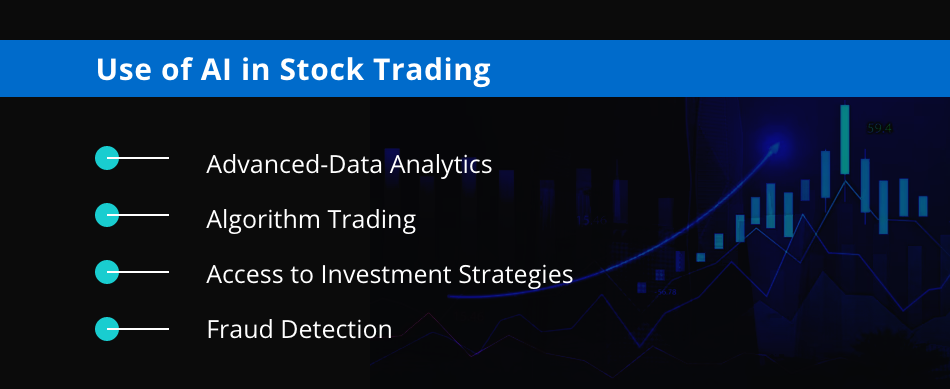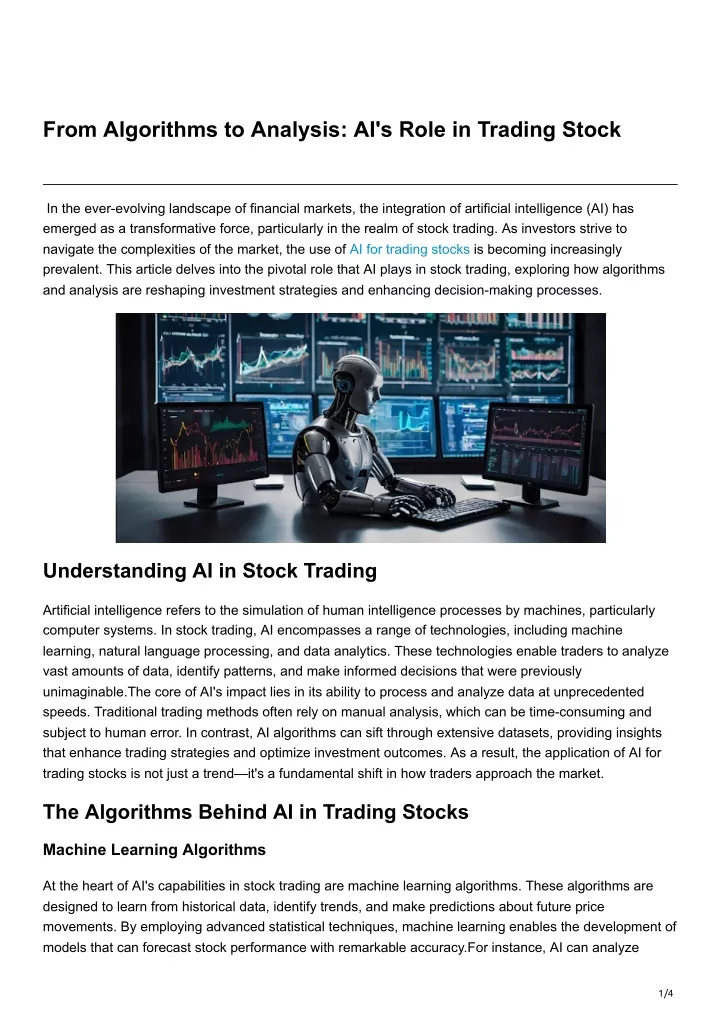20 Best Tips For Picking AI Stock Predictions Platform Websites
20 Best Tips For Picking AI Stock Predictions Platform Websites
Blog Article
Top 10 Suggestions On How To Evaluate The Quality Of Data And The Sources For Ai-Based Stock Analysis/Predicting Trading Platforms
To ensure accurate and reliable information, it is crucial to assess the quality of data sources as well as AI-driven stock trading platforms. Poor data quality can lead to flawed predictions, financial losses, and distrust in the platform. Here are ten of the most effective strategies to evaluate data sources and the quality.
1. Verify the data sources
Find out where the data came from: Make sure you make use of reputable and well-known providers of data.
Transparency. The platform should publicly disclose the sources of data it relies on and update these regularly.
Do not rely on one source: reliable platforms will frequently combine data from different sources to lessen bias.
2. Assess Data Frischness
Real-time data as opposed to. delayed data: Find out if your platform has real-time or delayed data. Real-time data is crucial for active trading, while delayed data can be sufficient to provide long-term analysis.
Update frequency: Find out how often the information is updated (e.g. minute-by-minute hourly, daily).
Data accuracy of the past Make sure that data is uniform and free of any anomalies or gaps.
3. Evaluate Data Completeness
Find missing data. Look for any gaps in the historical data, ticker-less tickers or financial statements that aren't complete.
Coverage: Make sure the platform provides a broad range of stocks, markets, indices and equities relevant to the strategies you use for trading.
Corporate actions: Make sure that your platform is able to take into account dividends and splits in stocks as well as mergers and other corporate events.
4. Accuracy of Test Data
Consistency of data can be assured through comparing the data from the platform to other reliable sources.
Error detection - Look for outliers and erroneous prices or financial indicators that aren't match.
Backtesting. Utilize old data to test your trading strategy to see whether it's in line with your expectations.
5. Examine the Data Granularity
The platform should provide granular details, such as intraday prices volume, bid-ask, and depth of order books.
Financial metrics: Ensure that the platform has detailed financial statements such as income statement, balance sheet and cash flow. Also, ensure that the platform has key ratios, such as P/E (P/B), ROE (return on equity) and so on. ).
6. Clean up and processing of data
Data normalization is important for ensuring consistency.
Outlier handling: Check the way in which the platform deals with outliers and anomalies in the data.
Missing estimation of data: Ensure that the system relies on reliable methods to fill in missing data.
7. Verify data consistency
Timezone alignment: Make sure that all data is aligned with the same timezone, to prevent discrepancies.
Format consistency - See if data are presented in the same way (e.g. units and currency).
Cross-market consistency: Verify data Harmonization across various markets or exchanges.
8. Evaluate the Relevance of Data
Relevance to the trading strategy Make sure the information is in line with your trading style (e.g. technical analysis, quantitative modeling, fundamental analysis).
Features selection: Check whether the platform provides useful features to improve your predictions (e.g. sentiment analysis macroeconomic indicator news data).
Examine Data Security Integrity
Data encryption - Ensure that your platform is using encryption to protect data during transmission and storage.
Tamper-proofing: Ensure that the data is not manipulated or altered by the platform.
Conformity: Check to see whether the platform is compliant with data protection regulations (e.g., GDPR, CCPPA, etc.).).
10. Test the Platform's AI Model Transparency
Explainability - Make sure the platform gives you insights into how the AI model makes use of the data in order to produce predictions.
Verify that bias detection is present. The platform must actively monitor and mitigate any biases that might exist within the model or data.
Performance metrics. Analyze performance metrics such as precision, accuracy, as well as recall to assess the validity of the system.
Bonus Tips
User reviews and reputation Check out feedback from users and reviews in order to determine the reliability of the platform and data quality.
Trial time. You can avail the demo or trial for free to test out the platform and its features.
Customer support: Check if the platform provides a dependable customer support to assist with data-related questions.
With these suggestions to help you better evaluate the data quality and sources of AI software for stock prediction, ensuring you make informed and reliable trading decisions. Take a look at the top ai stock trading bot free for site recommendations including trading ai, stock ai, investment ai, ai stock trading, market ai, trading with ai, ai investing app, ai chart analysis, ai investing, using ai to trade stocks and more.
Top 10 Suggestions For Evaluating The Accuracy And Scalability Of Stock Trading Platforms Based On Ai
To ensure that AI-driven stock trading and prediction platforms can be scaled as well, they should be able to cope with the ever-growing volume of data and complexity in markets, as well as user demands. Here are the top 10 suggestions on how to evaluate the scalability.
1. Evaluate Data Handling Capacity
Tip: Verify that the platform you are using is able to process and analyse huge databases.
Why: Scalable platform must be capable of handling the increasing data volume without performance degradation.
2. Test the Real-Time Processing Capability
See how the platform handles live data streams, such as price movements and breaking news.
Why? Real-time trading decisions require real-time data analysis. In the event of delays, it could result in missed opportunities.
3. Cloud Infrastructure and Elasticity The Cloud Infrastructure and Elasticity
Tips. Check if the platform uses cloud-based infrastructure, such as AWS, Google Cloud and Azure which are able to scale resources on demand.
Why: Cloud platform elasticity allows the size of the system to adapt based on usage.
4. Algorithm Efficiency
Tip: Determine the efficiency of AI models that are utilized to make predictions (e.g. Deep Learning and Reinforcement Learning).
Reason: Complex algorithms are resource-intensive. Thus, optimizing them will aid in scaling.
5. Study parallel processing and distributed computing
Verify if your system is running the concept of distributed computing or parallel processing (e.g. Apache Spark, Hadoop).
The reason is that these technologies accelerate data processing across multiple nodes.
Examine API Integration & Interoperability
Tips: Test the platform's ability to connect with APIs from outside (e.g., brokers, market data providers, APIs).
The reason: seamless platform integration allows it to adapt to any new sources of data or trading environments.
7. Analyze User Load Handling
You can simulate user traffic and observe how the platform responds.
Why is that a platform that can scale has to maintain its performance when users grow.
8. Examine the Retraining Model and its adaptability
Tip Assess how frequently the AI models are retrained on new data.
Why? Models have to constantly change to keep up with the ever-changing market to ensure that they remain precise.
9. Verify that Fault-Tolerance and Redundancy are in place.
TIP: Make sure your system has redundancy and failover mechanisms to handle hardware or software issues.
Why is that downtime in trading is costly, which is why fault tolerence is important for scaling.
10. Monitor Cost Efficiency
Tips: Think about the costs of scaling up your platform. Consider cloud resources such as storage of data and computing power.
What is the reason? Scalability shouldn't be at the cost of unsustainable costs. It is therefore important to find a balance between performance and cost.
Bonus Tip: Future-Proof
Making sure that the platform can be able to adapt to new technology (e.g. advanced NLP quantum computing, quantum computing) and regulatory changes.
It is possible to assess the capacity and effectiveness of AI trading and stock prediction systems by focusing on this aspect. This will guarantee that they're effective, robust and prepared for growth. Have a look at the top inciteai.com AI stock app for blog info including how to use ai for copyright trading, ai copyright signals, ai stock investing, ai trading tool, ai stock predictions, trading ai tool, ai trading tool, stocks ai, ai trading tool, best ai stocks and more.